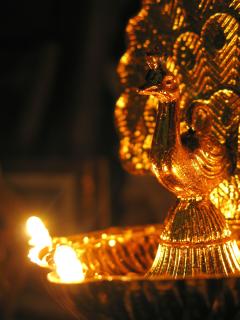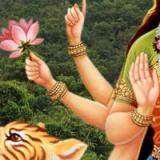
Indians are festival gluttons. That’s not to imply that we all eat too much during festivals (only most of us do, not ALL of us), but rather that we have more commonly celebrated festivals than you can shake a large decorated Christmas tree at. Speaking of Christmas, the Indian equivalent in the realm of noise, public participation, and pornographic commercialisation would have to be Deepawali or Diwali (as it is more commonly referred to in the north of the country). That is what we celebrate today.
Now, as is customary for any writer or speaker introducing the topic of Deepawali to a general audience, I am obliged to incessantly repeat what the festival is about and regale you with a few canned phrases that will enlighten you about the significance of something distilled down from a few thousand years of history and culture. But wait, I needn’t bother because the honourable President, Vice President, Prime Minister, Shadow Prime Minister *cough* big cheese of the ruling party, and probably a miscellaneous collection of other political types have been so kind as to release statements meant for the Indian public that repeatedly tell us what that festival we all seem to be so compelled to celebrate is all about … in one or two redundant sentences. The generally agreed version seems to be that it celebrates the victory of light over darkness, which in turn symbolises the victory of good over evil. Yes, I know. It’s deep. I’m so glad the leaders of our country think it important to educate us on these matters so repeatedly. I am very much expecting to find a multiple choice question about the significance of Diwali on the ballot papers during the next election. After all, how can we be truly Indian without fretting over irrelevant exams?
While the politicians assure me the correct translation of the phrase “victory of good over evil” is “communal harmony”, down south people are celebrating their individuality and the preeminence of their ancient(er) culture by reminding us once again that while they are good sports and wish you a Happy Diwali today (The day of Laxmi Pooja – more on that later), they actually celebrated Deepawali yesterday (Naraka Chaturthi by the Hindu calendar). On that day, aeons ago, Krishna killed the evil Narakasura, or maybe it was Kali who killed the evil Narakasura, or maybe it was the Goddess Durga who did the dispatching. No one seems to be quite sure, except about the fact that their version is more righteous than everyone else’s. Not to be out done, people in the North insist on calling Naraka Chaturthi “Choti Diwali” (Mini Diwali). My Diwali is bigger than yours.
Speaking of North India, aka Macho Land, they wouldn’t dream of basing their main festival on the victory of some vengeful superhuman woman over miscellaneous evil guy, so they insist it is the very day that Ram, of Ramayana fame, returned to Ayodhya after his many adventures and misadventures in the wild South. On the television news today I was informed that it all started when the people of Ayodhya lit up the city to welcome home their returning king and to celebrate his victory over the Demon King Ravana. I love it when people make unfortunate translations such as this one and eventually come to believe it themselves.
In the original Indian mythos, life exists in three realms (whether physical or spiritual is up to each person to decipher). Swarga (often translated as Heaven but not really) is the home of a race of super human beings called the Devas (often translated as Gods but not quite), Patala (often translated as Hell but not even close) is the home of the equally super human Asuras (often translated as Demons but not exactly), and Bhoomi (the Earth) is home to both human beings and all manner of other beings included the Rakshasas (also confusingly translated as Demons) who are actually meant to be nature spirits who inhabit the forests and the wilds. You can see the influence of Christian thought here, which made the Devil out of the playful Pan, but for Indians themselves to now consider the Rakshasa King Ravana as a “demon” while celebrating our wonderfully ancient culture (which we know nothing about) is truly sad and hilarious.
To confuse matters between Ram, Ravana, Krishna, Kali, Narkasura et. al., the second day of Diwali is also celebrated as Laxmi Pooja. For those who don’t know, a pooja is a ritual, usually directed at a particular deity. The Goddess Laxmi (pronounced Laksh-me) is the Goddess of wealth. Unfortunately, in our modern “enlightened” times, she has been reduced to the Goddess of riches, a major demotion from wealth, which signified so much more. On the day of Laxmi Pooja, people quite literally pray to and for money. The hardcore followers of the practice go so far as to not make any major purchases on the day, and hence keep the money from symbolically flowing away. Fortunately for the free market economy, they make up for this day of token level-headedness by going on a buying binge on all the days preceding it. Like Eid for the Muslims, or Christmas for the Christians, and Xmas for the cool folk, Diwali is an excuse for the urban Hindu to dig into their collection of fine vintage credit cards and live a life of blind consumption. And then there are the noisy fireworks that I am assured are “tradition” (that warrants a separate discussion).
This is the reality of Deepawali through most of the modern Indian world today. But, I have never considered myself a pessimist. Some where deep down in the dark recesses of the buying public there still exists some kernel of light. For what more do we need Deepawali to celebrate than light itself. We can marvel at the myths and revere the legends all we want, that is a healthy thing as long as we go beyond the fast food versions of the tales. But, do we really need Diwali to mean anything more than a few days in the year when we make night into day with our oil lamps and decorative kandeels(lanterns), our strings of cheap Chinese lights and faux LED oil lamps, and pay homage to the divine photon? It brings light into our lives, life into our universe, and beautiful sunrises over our horizons.
Happy Deepawali
Samir
Liked this article? Please share it: ![]()
![]()
![]()
![]()
![]()
![]()



hello samir – i hadn’t been here for quite a while, and i don’t know why. finally put you into my google reader. as always, your words sparkle on so many levels. i’ll add a link to your post on my wordless wednesday hommage to diwali.
Isabella, good to hear from you. Sorry for the delayed reply, but I was away from home base and not checking in here very often myself.
This article was written on the road, so to speak, and in the thick of Diwali in bustling Mumbai. I’m very glad to hear you enjoyed it, and I am always honored when anyone considers something I write to be worthy of mention.
Thank you, and I hope to get back into writing more soon. The blog has been very neglected in recent times, in spite of the fact that my need to write is ever present and never satisfied. Good to know there will be one more person listening.
Samir